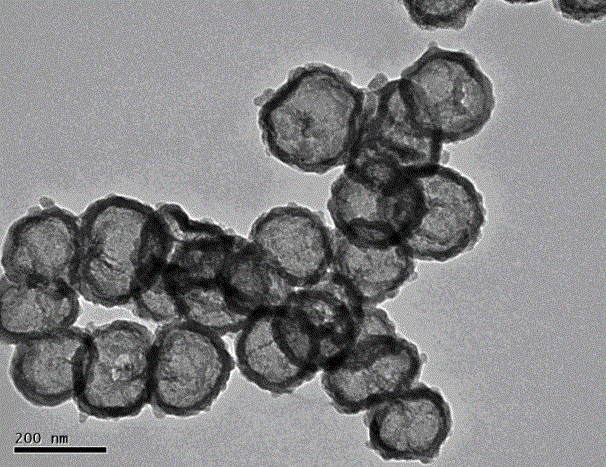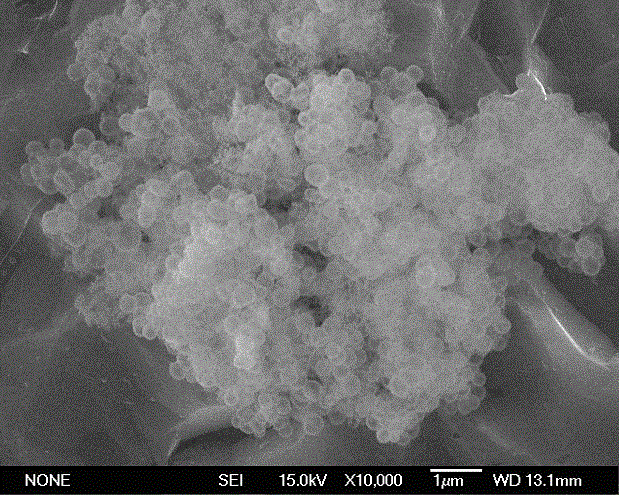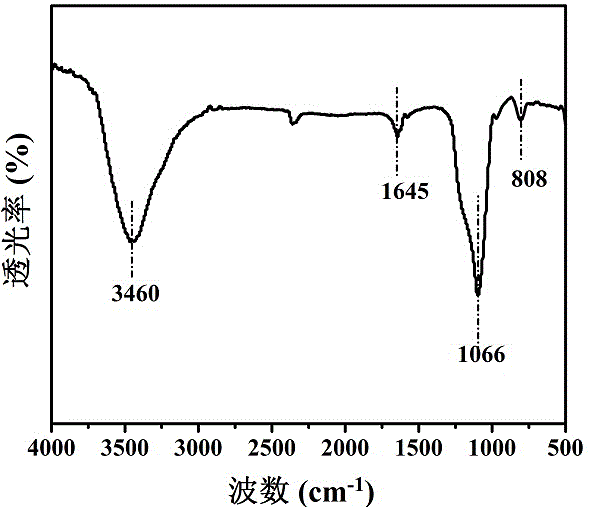Preparation method of hollow silicon dioxide nanomaterial
A technology of nanomaterials and silica, which is applied in the field of preparation of hollow silica nanomaterials, can solve problems such as uneven particle size, unsuitability for large-scale production, and irregular shape of materials, and achieve easy modification of the dispersed surface, shape The effect of controllable appearance and structure, uniform dispersion
- Summary
- Abstract
- Description
- Claims
- Application Information
AI Technical Summary
Problems solved by technology
Method used
Image
Examples
Embodiment 1
[0018] a. First prepare carbon spheres according to the existing known technology: Weigh 1.98 g of glucose with an electronic balance, add 20 mL of deionized water to sonicate until dissolved, and pour it into a 100 mL autoclave lined with polytetrafluoroethylene , reacted at 180 °C for 6 h, after the reaction was completed, the product was taken out from the reactor, centrifuged with ethanol and deionized water, washed, and dried at 60 °C to obtain a particle size of 180 nm Left and right carbon spheres with uniform shape;
[0019] b. Dissolve 50 mg of prepared carbon spheres in 20 mL of ethanol, then add 100 μL of 3-aminopropyltriethoxysilane (APTES), and stir at room temperature for 2 h;
[0020] c. Add 100 μL tetraethyl orthosilicate (TEOS) and 250 μL ammonia water (NH 3 ·H 2 O, 25~28 wt%), stirred at room temperature for 12 h and then centrifuged;
[0021] d. Dissolve the centrifuged product in 18 mL deionized water, add 0.0364 g cetyltrimethylammonium bromide (CTAB), ...
Embodiment 2
[0024] Example 2: The preparation process and steps of this example are basically the same as those of Example, the difference lies in step b:
[0025] 50 mg of the prepared carbon spheres were dissolved in 20 mL of ethanol without adding 3-aminopropyltriethoxysilane (APTES), and stirred at room temperature for 2 h.
[0026] The result obtained is quite different from the morphology of Example 1, a complete hollow spherical structure cannot be formed, the surface has many wrinkles, and the agglomeration is serious.
Embodiment 3
[0028] The preparation process and steps of this embodiment are basically the same as in Example 1, except that the d step:
[0029] Dissolve the centrifuged product in 18 mL deionized water, add 0.9 mL 0.001M NaOH, stir well, add 200 μL TEOS dropwise, and stir for 2 h; no cetyltrimethylammonium bromide (CTAB ).
[0030] The obtained result is quite different from the morphology of Example 1, and the product is a solid silica sphere with non-uniform particle size.
PUM
| Property | Measurement | Unit |
|---|---|---|
| thickness | aaaaa | aaaaa |
| particle diameter | aaaaa | aaaaa |
Abstract
Description
Claims
Application Information
 Login to View More
Login to View More - R&D
- Intellectual Property
- Life Sciences
- Materials
- Tech Scout
- Unparalleled Data Quality
- Higher Quality Content
- 60% Fewer Hallucinations
Browse by: Latest US Patents, China's latest patents, Technical Efficacy Thesaurus, Application Domain, Technology Topic, Popular Technical Reports.
© 2025 PatSnap. All rights reserved.Legal|Privacy policy|Modern Slavery Act Transparency Statement|Sitemap|About US| Contact US: help@patsnap.com



